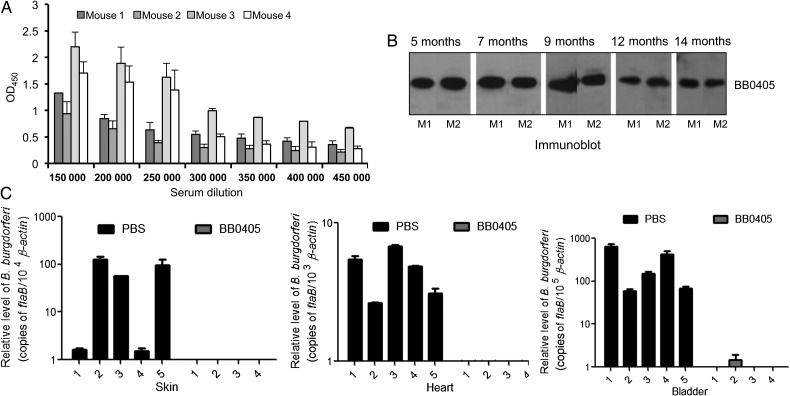Figure 5.
Active immunization of mice with recombinant BB0405 induces robust and long-lasting antibody responses and interferes with spirochete transmission from ticks. A, Enzyme-linked immunosorbent assay (ELISA) showing development of high-titer serum antibodies induced in recombinant BB0405-immunized mice. Groups of C3H mice (5 animals/group) were immunized with BB0405 or phosphate-buffered saline (PBS; control) mixed with an equal amount of adjuvant. Ten days after the final immunization, serum was collected and subjected to an ELISA. Wells were coated with recombinant BB0405 and probed with serially diluted normal mouse serum (NMS) or BB0405 antiserum. The data represent ODs for BB0405 titer after subtraction of corresponding NMS values. While 1 mouse generated low-titer antibodies (not shown), each of the other 4 mice developed very high-titer (>1:450 000) antisera. B, Immunoblot analysis showing long-lasting BB0405 antibodies in mice. Animals were immunized with recombinant protein as described in panel A, and serum samples were collected at weekly and monthly intervals until 14 months after immunization. While comparable levels of BB0405 antibody reactivity were recorded at all time points and in individual animals, a few representative times points for 2 mice (M1 and M2) are presented. C, Mice were immunized as described in panel A, and 10 days after the second boost, B. burgdorferi–infected nymphs were allowed to engorge on the naive immunized mice (5 ticks/mouse). Murine tissues were assessed for spirochete transmission 12 days after tick feeding. Total RNA was isolated, and flaB was measured using quantitative reverse transcription–polymerase chain reaction and normalized to the amount of mouse β-actin. The levels of B. burgdorferi in BB0405-immunized mice were either undetectable or significantly lower than in PBS-immunized animals (P < .05).

